Dans cette période de confinement où les interactions physiques sont limitées, nous sommes dans l’obligation d’animer nos ateliers à distance à l’aide d’une multitude d’outils. Même si ces derniers réduisent grandement notre peine, j’ai néanmoins la conviction que la distance physique nuit grandement à l’efficacité de la facilitation de groupe, que ce soit pour les participants ou pour l’animateur / animatrice.
Dans cet article, je vous propose de revivre avec moi une expérience d’un atelier facilité à distance avec mes difficultés, mes apprentissages et mes réflexions.
Bonne lecture à vous ! 🙂
Contexte et Enjeux

L’atelier en question correspond à la suite de l’article : « un atelier de clarification de rôle« .
L’idée principale est de confronter 2 visions d’un rôle intitulé « Tribe Lead » (correspondant à un Product Management IT).
Ce second atelier a alors plusieurs enjeux :
- En terme d’Objectifs
- Capitaliser sur la bonne dynamique engendrée par l’atelier précédent,
- Permettre aux Tribe Leads de s’exprimer sur leur vision du rôle qui a leur a été confié,
- Confronter les différentes visions pour s’accorder sur une vision commune à un instant t.
- En terme de Cadre
- Proposer une mécanique dans le même esprit que précédemment : c’est-à-dire participative, collective et contextuelle,
- et tout cela à distance.
Il est cependant nécessaire de préciser quelques contraintes spécifiques :
- Je n’ai pas connaissance du niveau d’aisance des participant(e)s avec la technologie
- Les habitudes de la maison sont d’avoir des réunions à distance en audio uniquement
- Au vu des difficultés techniques liées à une lenteur du réseau interne, un blocage des flux vidéos sur les postes internes a été mis en place
- Le choix d’outils de communication / collaboration est restreint à ceux validés par la sécurité du groupe
Conception et Préparation

En prenant les éléments de contexte précédents, nous voilà partis pour la conception de l’atelier.
Le cadre sera le suivant :
- un timing prévu d’1h30,
- un nombre de personnes estimé à moins de 10.
Pour le choix du timing, je suis reparti sur quelque chose de similaire à l’atelier précédent même si le contenu sera probablement plus riche en échanges et en interactions. C’est principalement pour un souci de clarté que j’ai préféré proposer une durée équivalente.
1. Agenda
2. Parking Lot

Au vu de l’historique de cette série d’ateliers, il me paraissait important que les participant(e)s aient la possibilité d’exprimer librement leurs questionnements, quelqu’en soit leur nature. En effet, dans un flou ambiant qu’une transformation peut générer, chacun a sa manière de gérer le stress, l’anxiété et l’inconnu. Pour cela, tout simplement, nous aurons une séquence de Parking Lot afin que chacun puisse y déposer ses principales interrogations.
Nous n’y répondrons pas tout de suite pour nous atteler au coeur de l’animation. Cependant, commencer par cette étape nous permettra non seulement de prendre le pouls, mais également au Management en présence de pouvoir réfléchir aux réponses.
3. Consensus Workshop
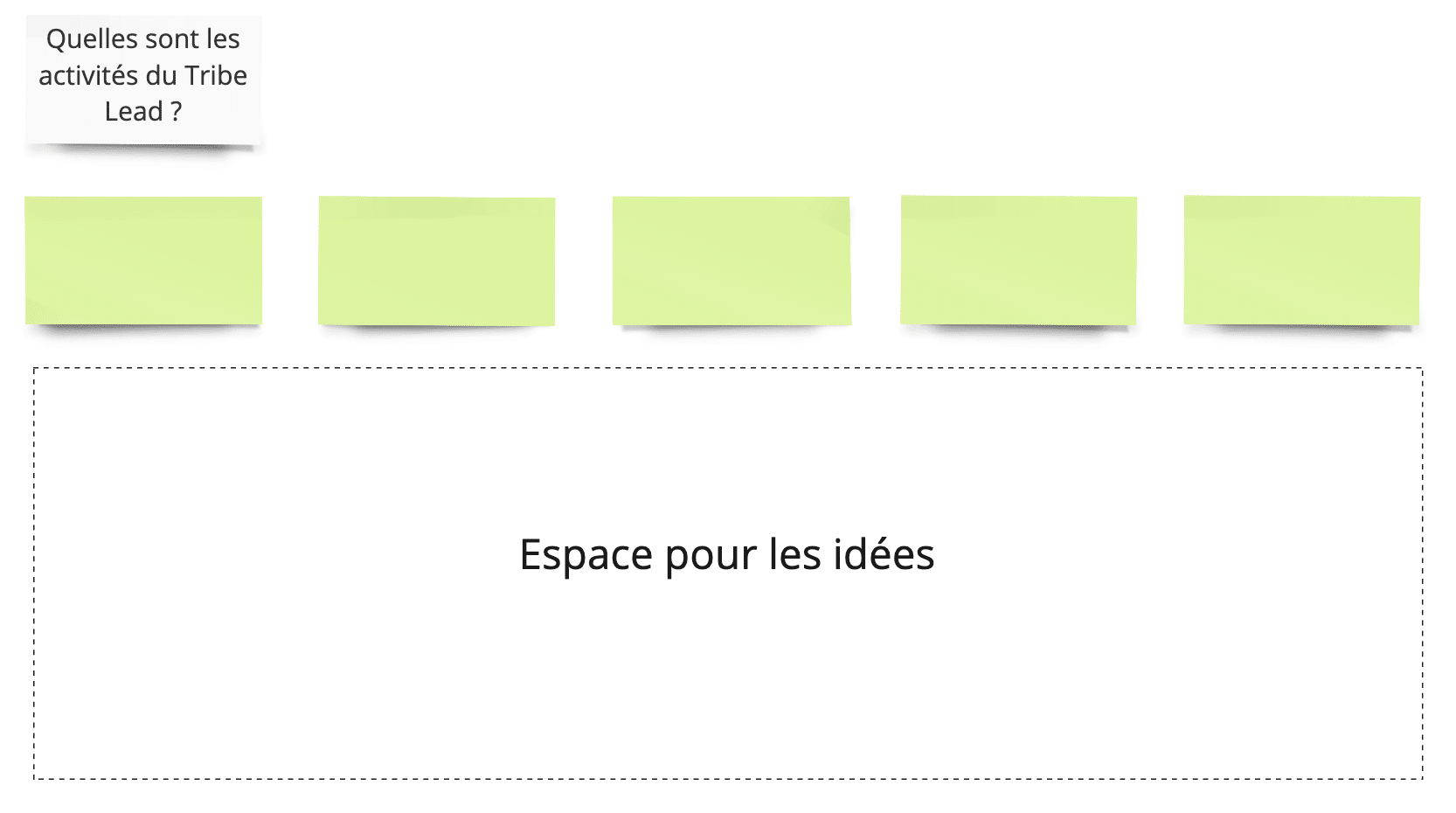
De la même manière que pour l’atelier précédent, je demanderais aux participant(e)s de répondre à la question suivante : « Quelles sont les activités du Tribe Lead ? ».
Il y aura néanmoins une différence dans la mécanique proposée à cause de contraintes techniques. En effet, j’avais l’intention d’utiliser Zoom et ses breakout rooms pour faire vivre la même expérience de pré-filtrage et d’échanges préalables aux Tribe Leads mais sa mauvaise presse actuelle en terme de sécurité m’en a dissuadé : mon client étant particulièrement pointilleux sur ces aspects.
J’ai donc décidé d’un mode dégradé :
- Temps de réflexion individuelle de 3 à 4 minutes,
- Passage chacun à son tour pour exprimer ses idées tout en enlevant les doublons : le pari étant que les derniers passages soient beaucoup plus rapides grâce au pré-filtrage,
- Nommage des catégories.
4. Vision consolidée
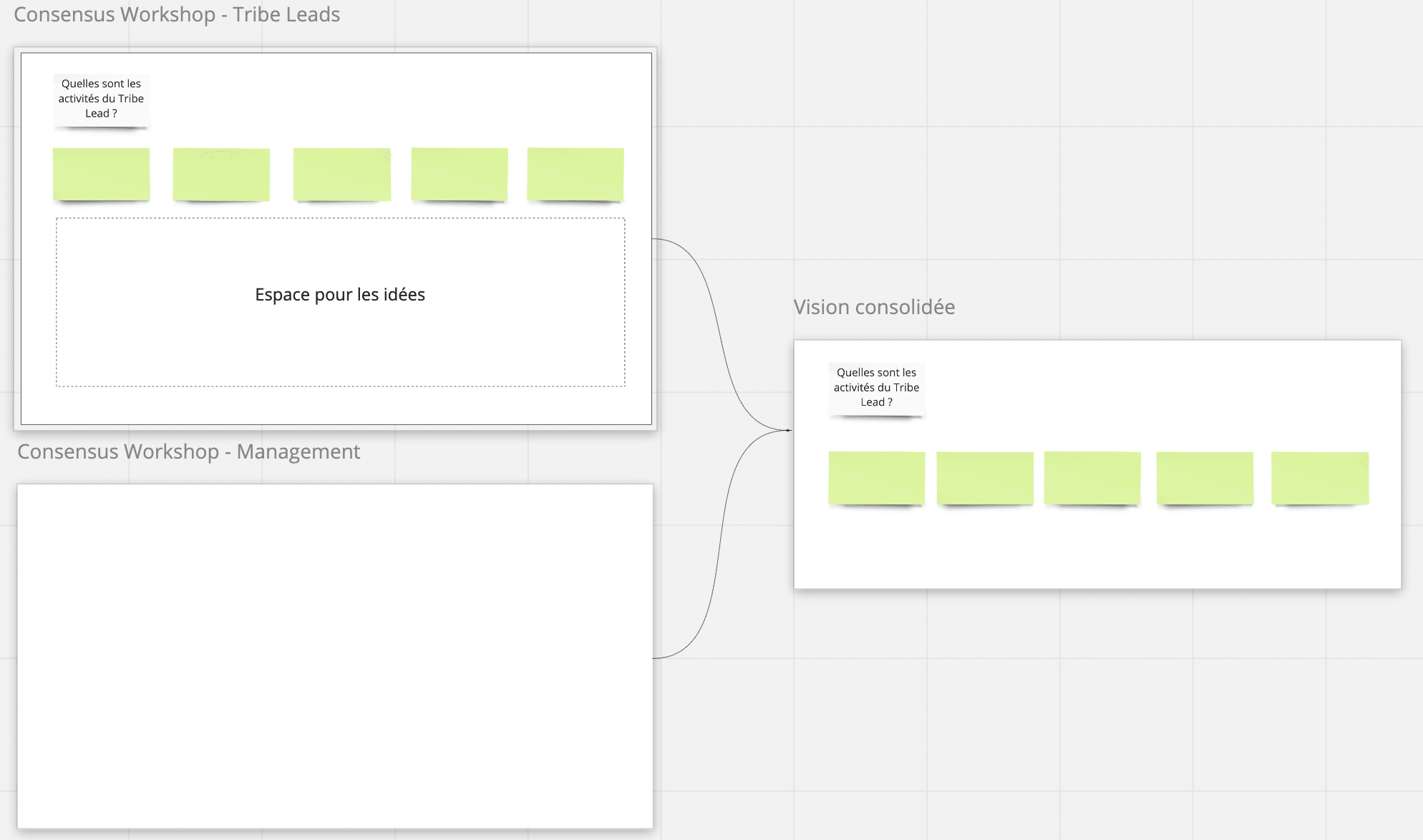
Après avoir obtenu une vision du côté des Tribe Leads, nous allons la confronter à la vision du management obtenue lors de l’atelier précédent. Ainsi pour ce faire, je demanderai au management en présence de prendre la main pour débriefer sur les éléments qui sont similaires et ceux qui sont différents. Ce sera alors une bonne occasion de créer des échanges, de lever les questionnements et de s’aligner sur certains sujets.
Comme pour l’atelier précédent, la version du Management sera cachée puis révélée au dernier moment pour permettre à chacun de pouvoir comparer les 2 visions.
Notre objectif ici sera de construire une vision consolidée sur la base des catégories (Post-it verts) plutôt que sur les activités. En effet, au vu de l’hétérogénéité des personnes présentes de par leur périmètre respectif, il me semblait plus judicieux de le faire ainsi pour donner plus de flexibilité à la mise en oeuvre sachant que chaque équipe peut avoir un mode de fonctionnement un peu différent.
| Note : c’est la même idée que de se focaliser sur les principes Agiles plutôt que sur les pratiques |
5. Questions / Réponses
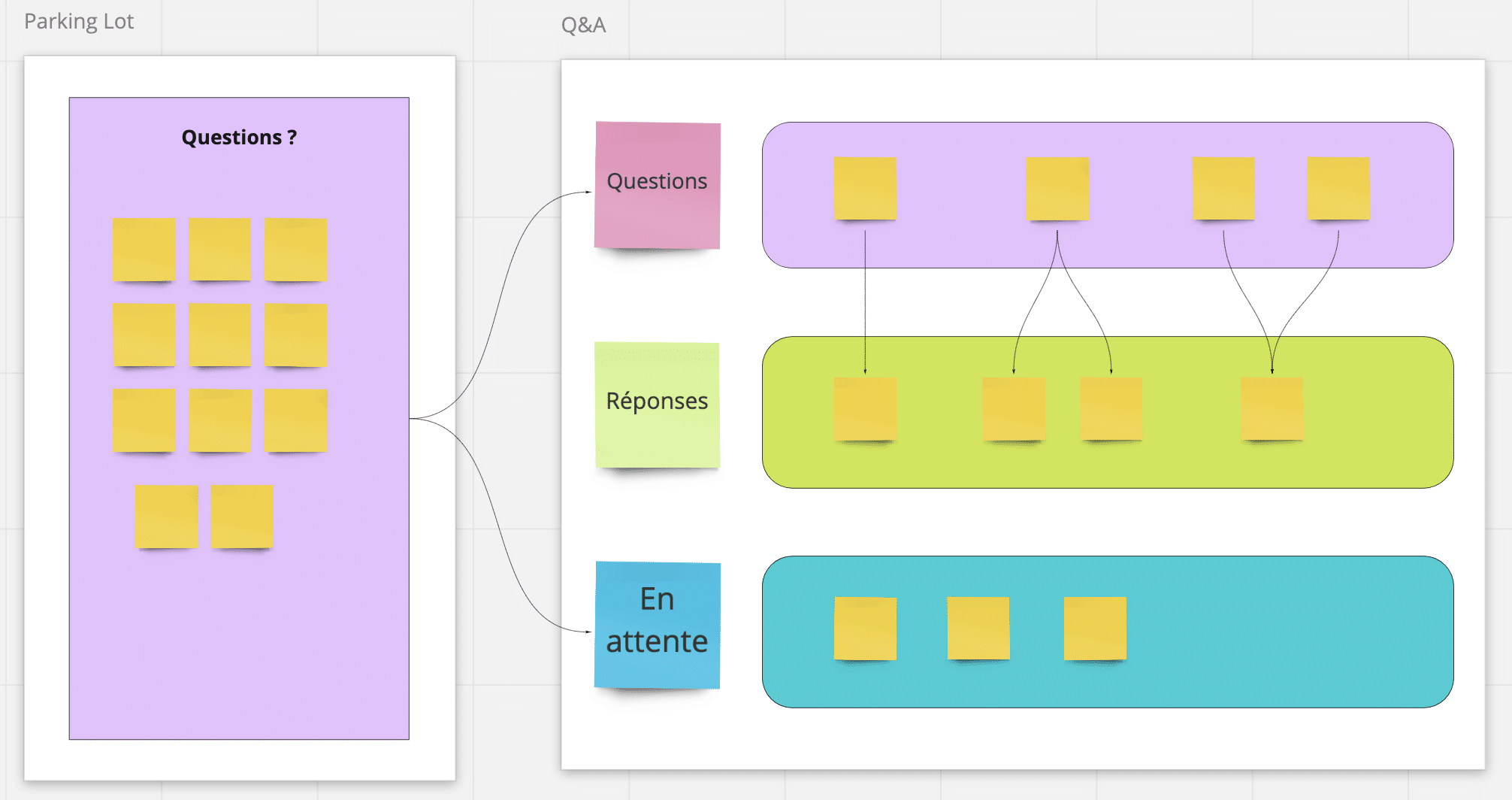
Un moment d’échanges autour des questions devra avoir lieu. L’idée étant bien évidemment d’en tacler un maximum pendant l’atelier. Le management en présence aura alors un support visuel pour préparer cette séquence avec une logique simple :
- un déplacement ou une copie du Post-it dans le bloc « Questions » ou « En Attente »,
- une ou plusieurs réponses dans le bloc réponses,
- et un lien permettant de relier les questions et les réponses : nous avons ainsi la flexibilité de couvrir les cas d’une question / une réponse, une question / plusieurs réponses et plusieurs questions / une réponse.
Par souci pédagogique, j’ai placé des flèches pour indiquer le sens de l’alimentation des 2 stocks
6. Next Steps

Pour conclure notre atelier, je proposerai aux participants de prioriser les prochaines étapes d’accompagnement selon leurs besoins du moment. En effet, plutôt que de simplement leur imposer la suite, je trouvais l’exercice de réflexion intéressant afin de pouvoir également de notre côté, organiser notre effort.
On présentera chaque élément avec les objectifs / apports escomptés afin de leur permettre d’ordonnancer de manière informée.
| Note : pour limiter au maximum les manipulations (le copier/coller dans ce cas), nous avons dupliqué chaque élément directement dans les boites de chacune des personnes mais par souci de lisibilité de l’article la liste n’apparaît qu’une seule fois. |
Préparations supplémentaires

Succès d’un atelier est en grande partie dans la préparation. C’est encore plus vrai à distance. Ainsi, pour limiter au maximum les temps de latence dans l’animation, j’ai entrepris quelques éléments de préparation supplémentaires que je vous expose ci-dessous :
1. Support Visuel
Pour animer un atelier de la sorte, il était essentiel de s’appuyer sur un support visuel commun afin de permettre aux participant(e)s de suivre le déroulé de l’atelier, de s’assurer de parler de la même chose et d’espérer se comprendre au mieux. Dans notre cas, nous allons utiliser Miro.
Techniquement parlant, Miro est un grand tableau blanc sur lequel on peut construire ce que l’on veut. La difficulté principale est alors de trouver la bonne chose, surtout lorsque le contenu devient assez conséquent. En effet, on est la plupart du temps obligé d’utiliser les fonctionnalités de zoom et de dé-zoom pour pouvoir s’y retrouver. J’ai alors utilisé le système intégré de Frames, permettant de se recentrer sur un contenu pré-déterminé pour permettre aux participants de passer d’une séquence à une autre avec plus de facilité.
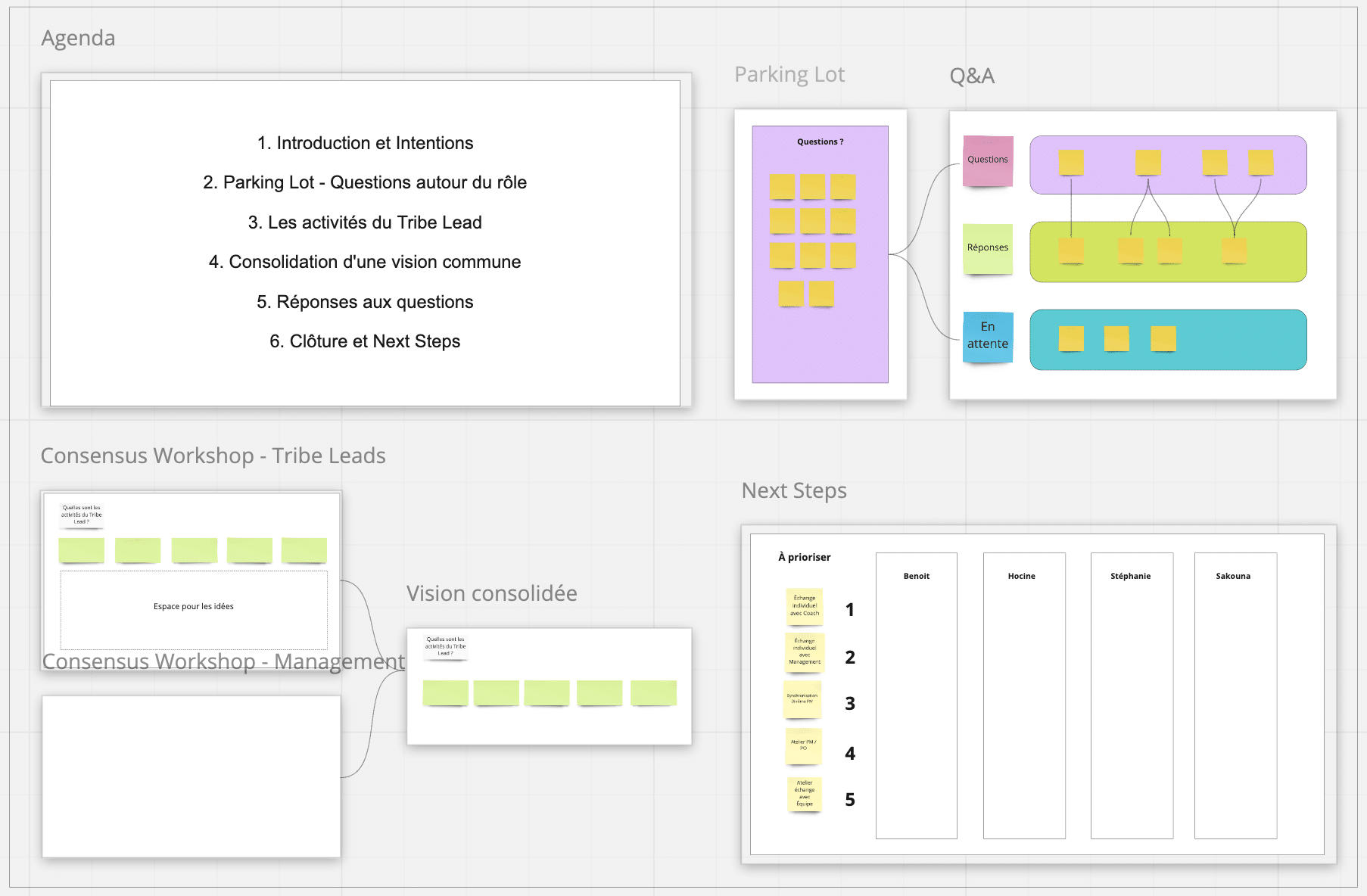
Ils pourront ainsi naviguer entre : l’agenda, le parking lot, le consensus workshop – Tribe Leads, le consensus workshop – Management, la vision consolidée, les questions / réponses et les next steps.
Après discussion avec mes collègues coachs, nous avons également décidé de mettre en place des zones spécifiques par participant avec des Post-its déjà prêts à l’emploi : en effet, cela leur permettra directement d’écrire leurs idées limitant ainsi le temps de latence pour trouver un espace, créer des Post-its et leur apposer un tag.
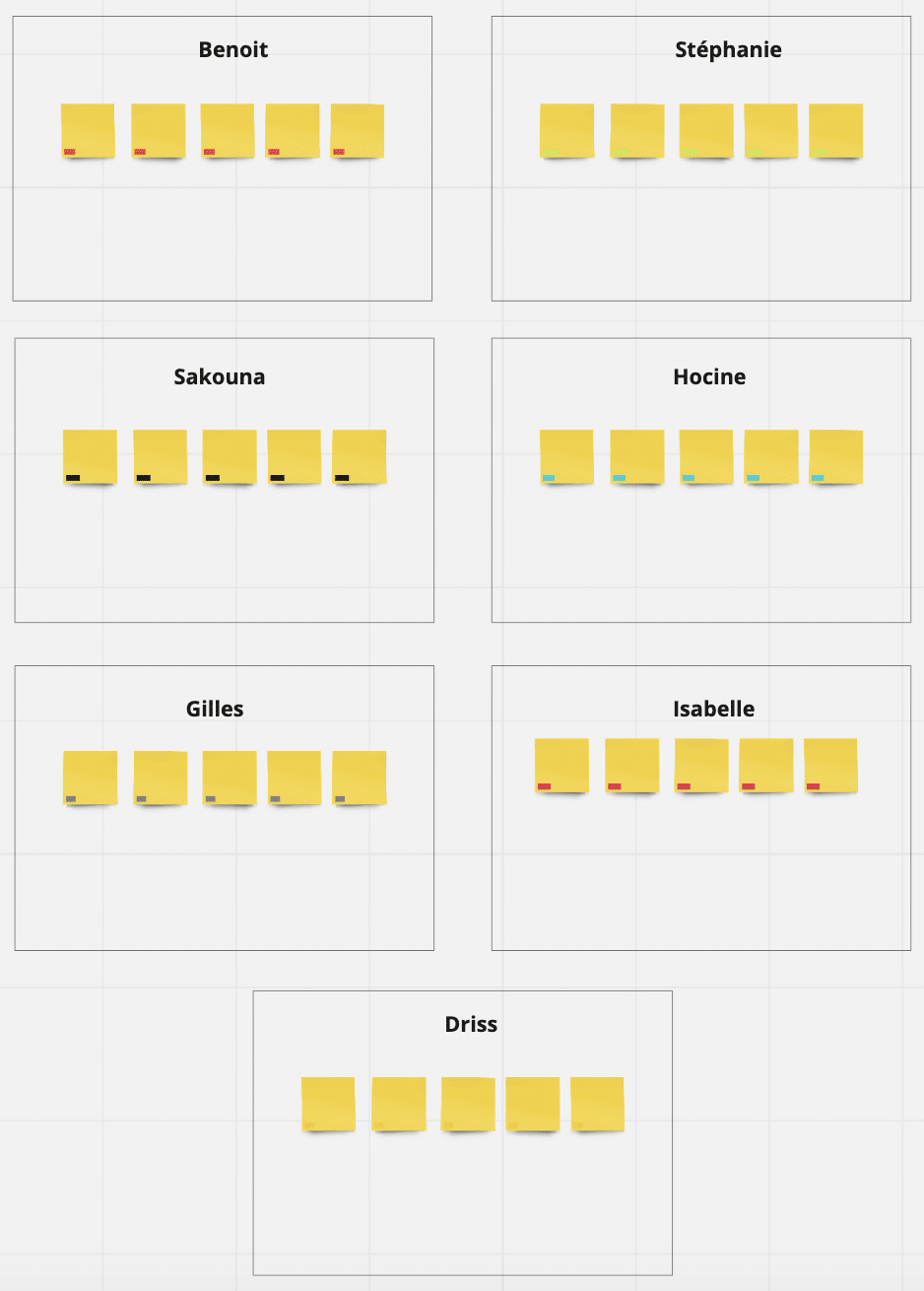
Enfin, pour éviter au maximum les erreurs de manipulations, j’ai figé le maximum d’éléments de cadre : seuls les Post-its étaient mobiles.
2. Briefing Participant(e)s
Une des grandes sources de temps perdu est la prise en main de l’outil par les participant(e)s en début de session.
Pour limiter au maximum ce risque, je leur ai envoyé un message avant l’atelier afin de m’assurer :
- qu’ils étaient bien en mesure d’accéder au support visuel : le réseau interne étant particulièrement capricieux ces derniers temps,
- qu’ils étaient capables d’effectuer les manipulations de base qui leurs seront demandées : déplacer un Post-it, écrire dans un Post-it, ajouter un tag, dupliquer un Post-it.
Je me suis d’ailleurs rendu disponible sur une plage horaire précédant l’atelier pour leur apporter mon aide au besoin.
3. Briefing Co-hôtes
Pour assurer mes arrières, j’ai également demandé à mes 2 collègues coachs de m’aider en terme de logistique et d’aide aux participants sur l’outil. En effet, je pense que c’est déjà un grand facteur de succès en présentiel, alors encore plus dans le cadre d’une animation à distance. Un élément supplémentaire non négligeable : c’est rassurant 🙂
Nous avons pris une bonne heure ensemble afin que je leur présente :
- le cadre d’animation,
- les différentes interventions prévues,
- le timing prévisionnel,
- les risques possibles de dérives,
- et le support visuel.
Cela nous a permis d’être bien synchrones pendant l’animation avec un rôle bien clair pour chacun.
4. Briefing Managers
Les enjeux de cet atelier étant d’ouvrir l’échange entre des niveaux hiérarchiques différents, il était important pour moi de faire intervenir la couche de Management dans l’animation.
J’ai donc pris un moment avec eux pour leur préciser la nature des interventions dont j’avais besoin de leur part :
-
- Introduction : pour préciser les intentions et enjeux de l’atelier, dit autrement « pourquoi les participant(e)s sont là ». Je ne voulais absolument pas que l’atelier soit subi comme un « impondérable » de la transformation mais plutôt comme un besoin provenant de l’interne.
Je prendrais la main par la suite.
-
- Parking Lot : pendant que les participant(e)s rempliront les Post-its avec leurs questions, le management aura pour mission d’en préparer les réponses si elles sont connues. En effet, on ne sait jamais vraiment sur quoi on va tomber donc on accepte que des questions puissent rester sans réponse (tout du moins pendant l’atelier).
L’idée principale étant d’accélérer la séquence de questions / réponses de fin d’atelier.
-
- Consensus Workshop – Tribe Lead : je les invite à bien rester à l’écoute de ce qui se dira pendant la séquence. En effet, cela les aidera à faire la comparaison avec leurs propres résultats.
L’idée ici est qu’ils ne participent pas mais se nourrissent du contenu pour pouvoir intervenir de manière pertinente par la suite.
-
- Consolidation Vision Commune : je leur demande alors de participer à cette phase en décrivant rapidement ce qui est similaire mais de prendre du temps surtout sur les différences que ce soit par ajout ou par omission. Je leur transmets d’ailleurs le résultat de leur atelier précédent pour l’avoir en visibilité et pouvoir comparer plus facilement.
L’objectif ici est de créer l’échange afin de converger vers une vision consolidée.
-
- Questions / Réponses : j’animerai la partie de questions/réponses afin de rythmer les discussions mais les échanges seront bien évidemment entre le Management et les Tribe Leads.
J’espère ici que le nombre de questions ait bien réduit pendant l’atelier !
-
- Next Steps : rien de particulier ici pour eux mis à part une attention particulière à une action les concernant intitulée : « échange individuel avec le Management ». C’est une action sur laquelle j’avais insisté car il me paraissait essentiel que le Management tisse un lien avec chaque personne individuellement, pour avoir son ressenti suite à l’atelier et surtout ses potentielles craintes, peut-être non exprimables en groupe. Le positionnement de cette action dans le backlog de chaque participant permettra au Management de prendre ses dispositions de manière adaptée.
On voit donc que le rôle des Managers dans l’animation est essentiel. Cela leur permet ainsi d’être totalement engagés et parties prenantes du contenu qui émergera de l’atelier.
Animation
Après une nuit de sommeil agitée, nous voilà enfin arrivés à l’heure fatidique.
14:00 – Dernières vérifications avant l’atelier
Une bonne heure et demie avant, j’effectue quelques vérifications au niveau de la connexion sur le support visuel. En effet, ayant la possibilité de voir les membres activés et leur adresse e-mail associée, je pouvais voir si les participants avaient bien pris le temps de se créer un compte si ce n’était pas déjà fait ou bien d’accéder à l’espace, tout simplement. Bien évidemment, encore 3 personnes manquaient à l’appel.
5 minutes avant le démarrage, j’apprends qu’une personne ne participera finalement pas à notre atelier. Il ne me reste donc qu’à bien m’assurer que les 2 personnes manquantes seront opérationnelles.
15:30 – Début de l’atelier
Sans surprise, nous commençons avec une petite dizaine de minutes de retard, le temps que tout le monde arrive et que la dernière personne crée son compte et se connecte sur Miro. Cela se fait finalement plutôt bien et nous pouvons ainsi démarrer.
Cet atelier étant très attendu, une petite dizaine de personnes y sont connectées en plus, en tant qu’observateurs. J’en profite pour bien préciser les règles :
Les seules personnes autorisées à parler sont les personnes participant à l’atelier.
Je demanderais aux autres de bien vouloir couper leurs micros pour limiter au maximum les interférences extérieures. Merci !
15:40 – Introduction
Nous démarrons alors avec l’introduction prise en charge par les Managers. Ils expriment en quelques minutes leurs constats, les difficultés rencontrées sur le chemin et ainsi les intentions de cet atelier. C’est parfait, je reprends ainsi la main !
Passons au Parking Lot.
15:45 – Parking Lot
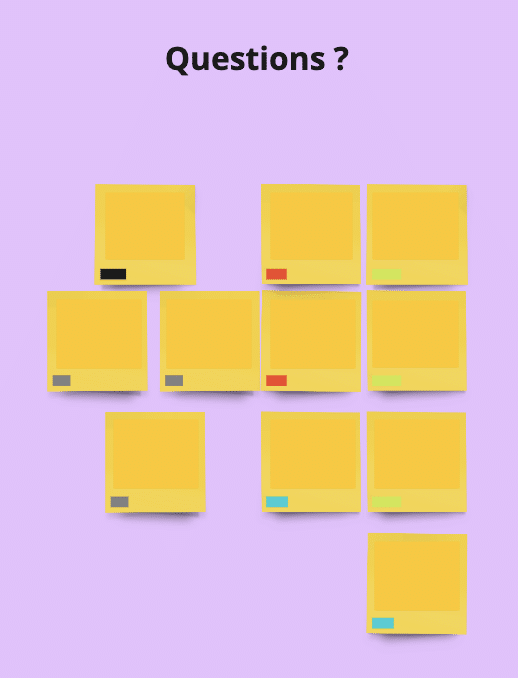
Je dirige alors les participants sur la zone de Parking. Après avoir donné les consignes, j’attends les premiers mouvements de souris ainsi que les premiers Post-its. Cependant, les participant(e)s semblent timides et rien ne se passe pendant une bonne trentaine de secondes. Je suis obligé de relancer pour savoir s’il n’y a effectivement aucune question ou si c’est le temps de la réflexion.
Des personnes se lancent enfin et l’on peut voir leurs différences de personnalité à leur manière d’écrire dans leurs Post-its. Certains hésitent, d’autres sont très inspirés et même commencent à faire des blagues. Pour le coup, le jeu en vaut la chandelle : l’ambiance est bonne, les participants sont en mouvement et s’approprient l’outil.
Une petite de dizaine de Post-its plus tard, nous enchaînons sur la séquence suivante.
| Note de facilitateur : mon attention se porte non seulement sur les mouvements des participants mais également sur les mouvements de mes collègues coachs en support. Tout le monde est bien présent, c’est encourageant. Je m’attends alors à voir les souris des managers bouger pour commencer à traiter les différentes questions et à ma grande surprise, peu de choses se passent. C’est étrange. Je dois néanmoins continuer à animer la suite. |
15:50 – Consensus Workshop
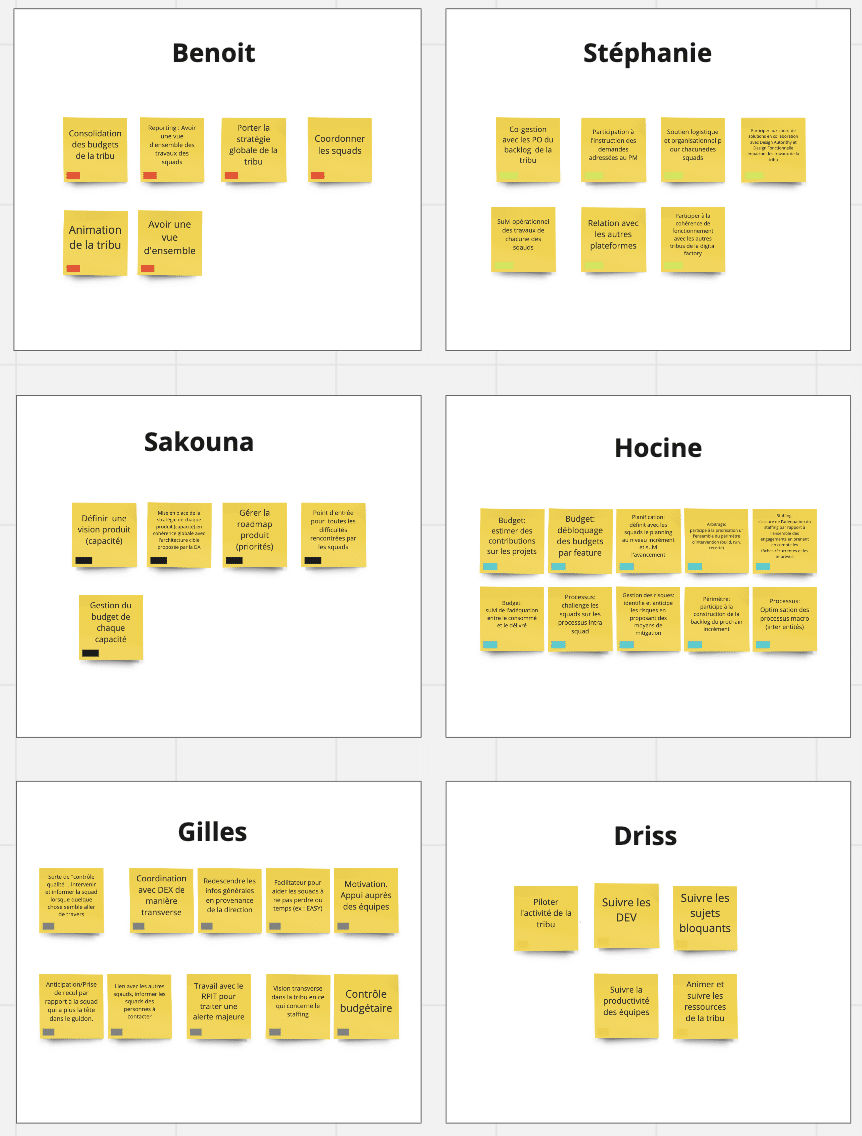
Nous nous dirigeons ensuite sur la zone de Consensus Workshop. Je précise aux participant(e)s que cette zone sera dédiée au débriefing et qu’ils ont juste à côté un espace qui leur est affecté.
Pour orienter au mieux les participant(e)s sur l’espace de travail, les coachs commencent à tracer de grandes flèches pour indiquer la direction à suivre. Cela semble plutôt bien fonctionner : tout le monde semble trouver facilement son espace. Nous pouvons donc commencer la mécanique.
Je laisse alors 5 minutes à chacun(e) pour répondre à la question. Je leur précise qu’il n’y a pas un nombre attendu de réponses et que l’important est de répondre de leur propre référentiel.
J’en profite pour regarder du côté de la zone de Questions / Réponses et je commence à voir quelques mouvements de souris des managers. Il y a surtout des regroupements de questions pour le moment, ce n’est pas grave en soi mais je trouve que leur vitesse d’exécution n’est pas très élevée. Peut-être ont-ils des problèmes techniques ?
Lorsque quelques souris arrêtent de bouger, je demande aux participant(e)s si l’on peut enchaîner. Les réponses ne viennent pas tout de suite, certaines personnes étant encore en train d’écrire des choses : il est néanmoins intéressant de voir que certains semblent beaucoup plus inspirés lorsqu’on leur demande s’ils ont fini.
| Note de facilitateur : la difficulté de l’exercice est que je ne suis ici qu’en supposition, étant totalement aveugle sur le non-verbal des personnes. Je pars également sur le principe que chacun va répondre honnêtement avec ses propres idées plutôt que de regarder chez les autres pour avoir les « bonnes » réponses. |
Je lance alors la phase de débriefing, plutôt confiant sur le timing jusqu’ici.
16:00 – Debriefing Consensus Workshop
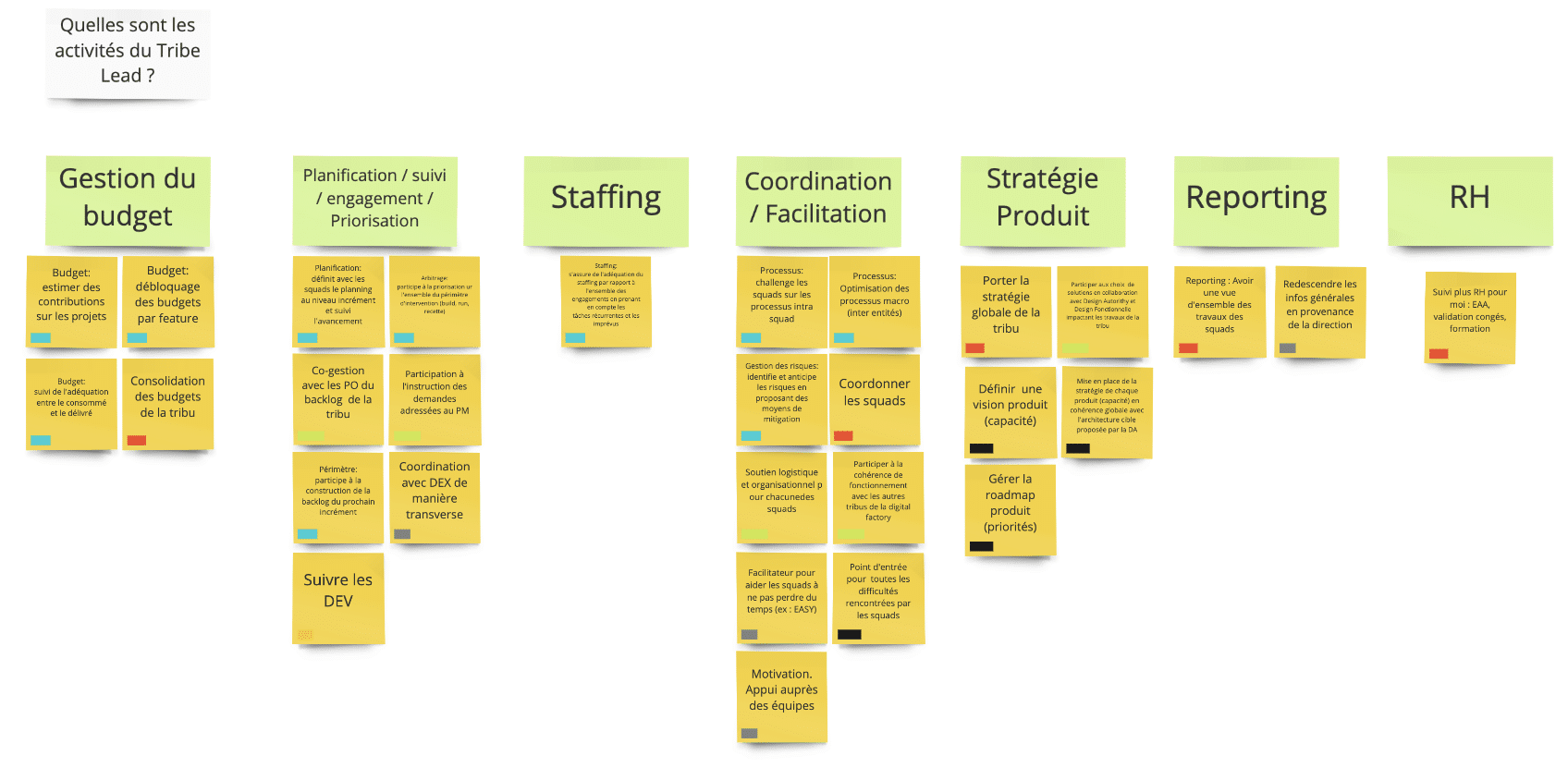
J’invite alors une personne à commencer pour donner l’impulsion. J’ai de la chance, un participant particulièrement constructif se lance. C’est d’ailleurs celui ayant le plus de Post-its, une bonne occasion de filtrer les réponses de l’ensemble du groupe !
Il expose ainsi ses idées les unes après les autres de manière très structurée, tellement structurée qu’il les a déjà classées sous des catégories. Cela est un peu quitte ou double dans le sens où cela peut être une source d’influence pour les autres, mais soit, faisons avec. De plus, étant le premier à passer, il fait office d’exemple aux autres. La problématique est que voulant bien faire, il a tendance à rentrer dans un niveau de détail non nécessaire ce qui allonge son monologue et ralentit le rythme de l’atelier.
| Note de facilitateur : il m’est d’ailleurs beaucoup plus difficile de le couper dans ses explications n’ayant pas mes repères corporels habituels. Mon intention étant avant tout de le laisser s’exprimer tout en gardant la main sur le cadre. Je me dis alors qu’il est important de rythmer le passage de chaque personne pour ne pas trop déborder du timing. |
Nous enchaînons alors avec les autres, chacun à leur tour, en regroupant au mieux les différentes idées. Je sens que le rythme de l’atelier faiblit et c’est compréhensible : 6 passages individuels d’affilée peut facilement faire perdre la concentration des participants. Je me sens moi-même en perte d’énergie, devant être très attentif à chaque discours pour sentir où redonner de l’impulsion et du rythme.
Malgré mes efforts, nous en sommes tout de même ressortis avec 7 catégories distinctes. En effet, cela semblait tenir à coeur à certains participants de garder des sujets bien séparés et ce n’est pas une bataille qui me paraissait utile à mener. Nous sommes alors passés à la phase de nommage.
Pour rendre la séquence la plus efficace possible, j’ai décidé d’être un peu plus directif. En effet, j’ai commencé par faire des propositions sur les catégories les plus évidentes pour donner une dynamique puis j’ai sollicité des propositions pour les catégories plus complexes.
| Note de facilitateur : ce fut un moment très énergivore pour moi car j’ai du relancer à de multiples reprises les participant(e)s par un « Allo ? » tellement le silence me faisait parfois douter de leur présence. |
Après avoir obtenu une vision partagé du côté des Tribe Leads, il était maintenant temps de confronter les différentes visions afin de construire une vision consolidée.
16:45 – Vision consolidée
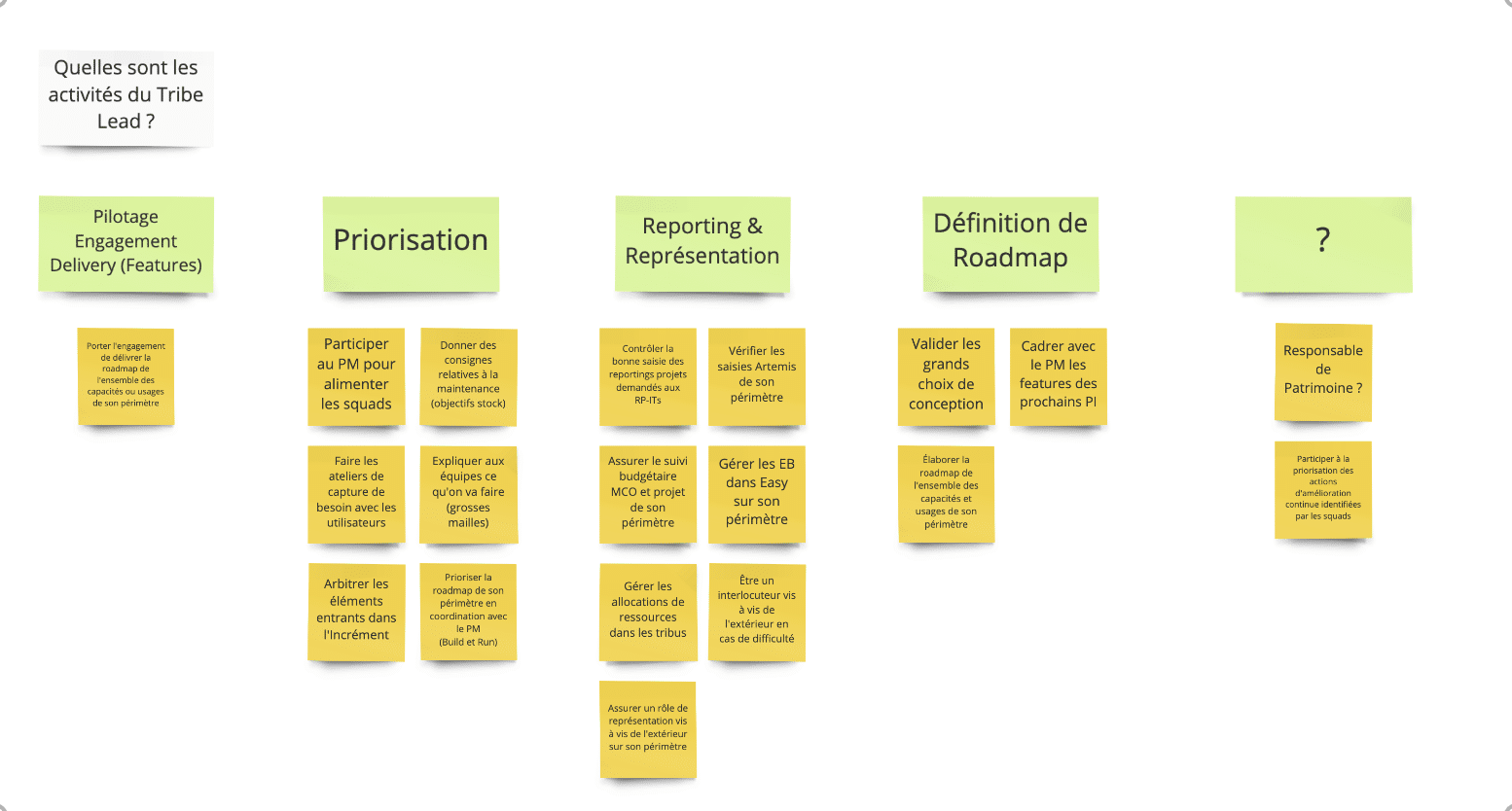
Alors que je dévoile le résultat du Consensus Workshop – Management à l’audience, j’invite les Managers à reprendre la main pour effectuer la comparaison. J’espère alors que ce passage de relai dans l’animation redonne un peu de rythme aux échanges.
Ils partagent dans un premier temps autour des éléments évoqués des 2 côtés, malgré un nommage peut-être un peu différent. J’en profite entre 2 échanges pour compléter la vision consolidée avec ces éléments en m’assurant que la terminologie employée convient à tout le monde.
Un débat éclate alors au niveau des sujets « qu’il ne fallait pas séparer ». En effet, les visions diffèrent sur ces éléments et malheureusement toutes les personnes concernées ne sont pas présentes pour contribuer. Je tente alors d’abréger la discussion afin de la reconduire dans le cadre d’un atelier plus spécifique avec les bonnes personnes : chose en fait déjà assez difficile en physique lorsque des personnes échangent de manière assez engagée sur un sujet, alors à distance, j’ai dû faire preuve d’insistance pour couper les discussions. Pour matérialiser le fait que ces sujets étaient en suspens mais qu’ils faisaient bien partie de la vision consolidée, je leur ai rajouté un « ? » à côté.
On obtient alors le résultat suivant :

| Note de facilitateur : à ce moment, il m’est important de décaler le regard des participants sur le résultat possiblement atteignable pendant l’atelier. En effet, plutôt que d’espérer avoir une vision consolidée claire, partagée et figée, il m’apparaissait plus raisonnable de considérer les éléments sur lesquels ils étaient d’accord et ceux qui nécessitaient un échange complémentaire. |
17:05 – Questions / Réponses
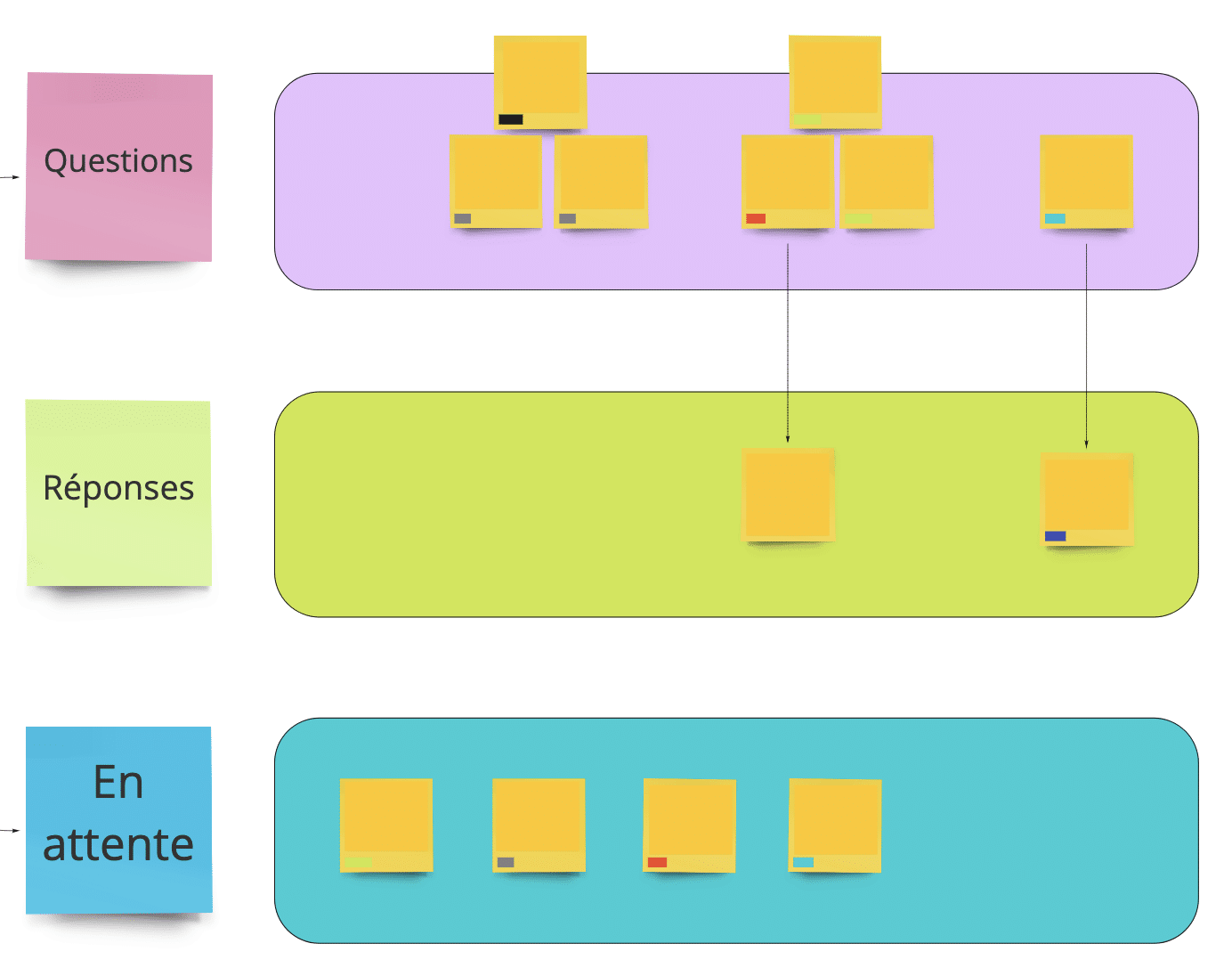
La séquence de Questions / Réponses fut assez rapide car la plupart des questions encore en attente nécessitaient d’organiser un atelier dédié avec potentiellement d’autres acteurs. J’ai donc invité les participant(e)s à passer à la dernière séquence pour pouvoir clôturer l’atelier avec un débordement le plus limité possible.
| Note de facilitateur : le dépassement du timing m’apparaissait déjà comme un échec en tant que facilitateur. Peut-être suis-je un peu dur avec moi-même mais il m’était important de limiter le débordement au maximum pour que les participants ne considèrent pas cela normal de déborder à chaque fois : une habitude malheureusement bien trop présente en entreprise. |
17h15 – Next Steps
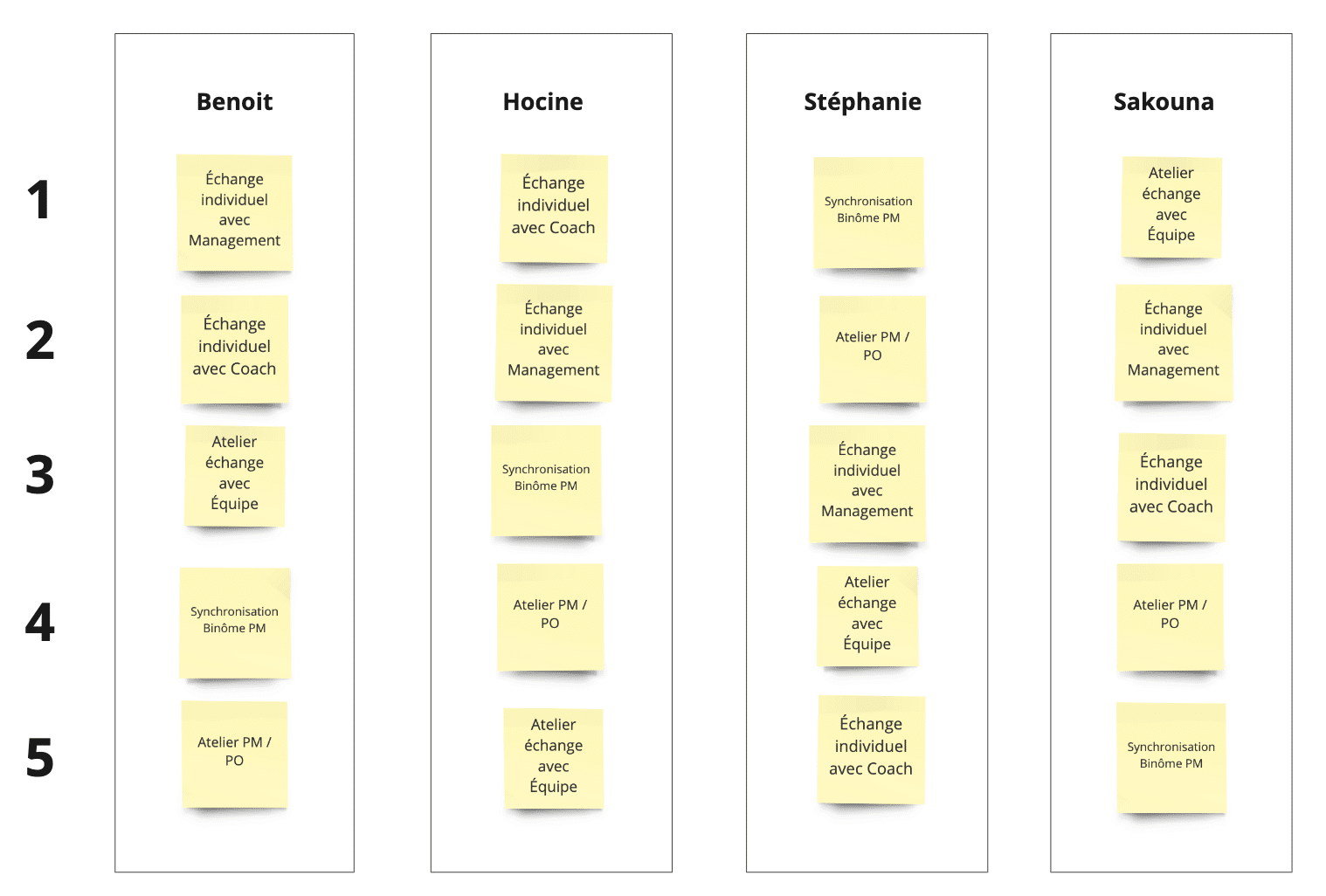
Cette partie se déroule plutôt bien, nous sommes en fin d’atelier et la consigne est plutôt simple. J’explicite juste chaque élément de backlog avant de laisser la main aux participants pour leur priorisation.
Lorsque les mouvements apparaissent moins nombreux, je demande une confirmation à chaque personne pour pouvoir clôturer l’atelier.
17:20 – Conclusion et fin de l’atelier
Pour terminer, j’ai demandé quelques mots de la part des managers sur l’atelier en lui-même et les résultats obtenus.
Les avis étaient partagés : non pas qu’il y ait eu une insatisfaction quelconque mais plutôt un sentiment d’inachevé. En effet, le fait d’avoir fait émerger un certain nombre de questions en fin d’atelier et de ne pas avoir pu y répondre, que ce soit par manque de contenu soit par manque de temps, a pu être frustrant. C’est pourquoi nous avons décidé qu’il y aurait un autre atelier pour traiter les questions restantes voire même d’autres qui émergeraient entre temps ainsi que pour finaliser une vision consolidée partagée.
J’ai eu par la suite l’occasion d’échanger en privé pour avoir leur retour : ils étaient globalement satisfaits même si ce n’était pas pour les mêmes raisons.
En effet, ils ont tous les 2 trouvé l’atelier particulièrement fluide (merci à mes collègues coachs) malgré les conditions pas très avantageuses et surtout très différente de ce que eux avaient pu vivre.
L’un d’eux me partagea d’ailleurs qu’il était sceptique au départ et agréablement surpris de ce que l’on a pu produire. Sa frustration principale est de ne pas avoir pu débattre plus longtemps sur les sujets qui n’étaient pas communs. C’est pourquoi un prochain atelier à ce sujet va être important !
L’autre m’indiqua que l’expérience en elle-même était très enrichissante que ce soit dans le contenu mais également dans le cadre : il lui semblait étonnement possible de voir les différences de comportement au travers des mouvements de souris et des interventions de chacun(e) pendant l’atelier ce qui lui fut très révélateur !
Conclusion

Cet atelier a été un grand défi pour moi qui n’ait pas forcément l’habitude d’animer entièrement à distance, sans avoir vu les personnes au préalable : en tant que facilitateur, je travaille beaucoup avec le non-verbal pour ajuster non seulement ma posture mais également mon niveau d’intervention avec les participant(e)s. Ici, impossible de le faire au vu des contraintes techniques et des habitudes des participant(e)s malheureusement.
Malgré les retours relativement positifs, je ressors personnellement un peu mitigé et extrêmement fatigué. En effet, étant donné un niveau de préparation bien supérieur à la normale, j’ai été surpris de devoir fournir autant d’énergie dans cette animation. Je n’arrive donc pas très bien à comprendre les gens qui disent que le passage en full remote n’a rien changé dans leur productivité : peut-être n’avons nous pas la même définition d’une « interaction » ou peut-être que je n’ai pas les compétences nécessaires à ce jour pour que ce soit le cas.
Cette expérience fut néanmoins riche en apprentissage pour moi. Un merci d’ailleurs tout particulier à mes collègues Alexis Huet et Jacques Labatte pour leur aide précieuse !
Maintenant si j’avais néanmoins quelques conseils à partager pour l’animation d’ateliers à distance :
|
Remarque : ces conseils sont également applicables pour de l’animation en présentiel, ils m’apparaissent simplement d’autant plus importants en distanciel !
J’espère que mon témoignage aura pu susciter quelques réflexions intéressantes chez vous ! Si c’est le cas, n’hésitez pas à me les partager pour que l’on échange, j’en serais ravi ! 🙂

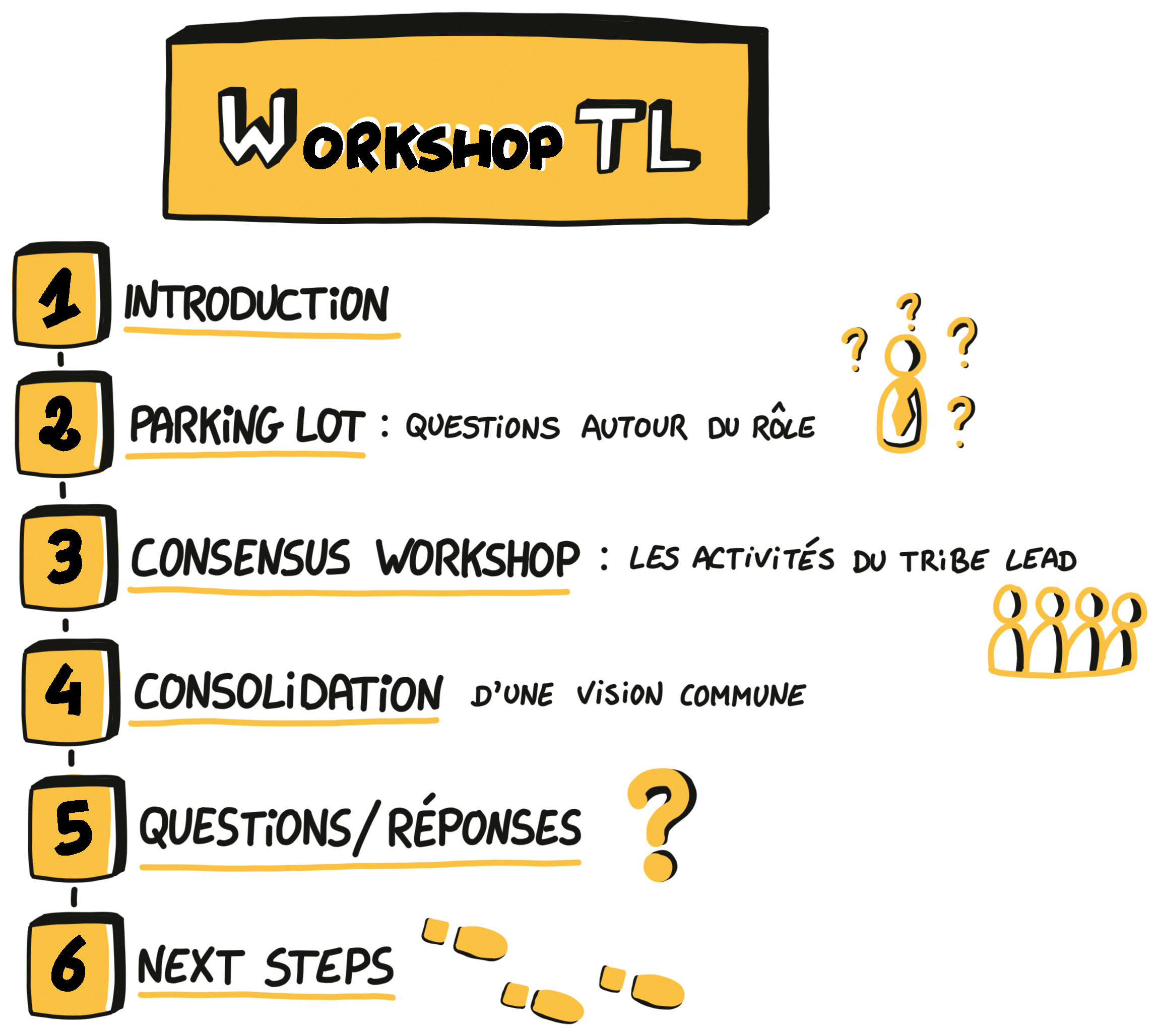






9 réponses
Merci Olivier pour cet article. C’est pascale Liroy qui m’a recommandé de le lire car je suis extrêmement intéressée par tout ceci.
Je suis de l’avis que faire ce genre de travail en remote est épuisant. Et enchaîner pour certains des zooms à gogo est éreintant. J’ai eu des retours de managers à ce sujet. Et ma propre expérience me fait dire la même chose.
Merci encore pour cette belle découverte d’outils et l’histoire de votre propre expérience.
Laure
Merci pour votre message. Je pense qu’il est effectivement d’autant plus important aujourd’hui de se poser les bonnes questions dans notre gestion des moments de rencontres (réunions, ateliers…) car notre attention et notre énergie ne sont pas sollicitées de la même manière. De mon point de vue, faire plus court mais plus souvent semble être plus approprié à l’ère de la complexité et de l’incertitude 🙂
Une belle journée à vous !
Olivier
Olivier,
Frames est-il un outil collaboratif ?
Merci
Laure
Bonjour Laure,
Alors je ne sais pas si nous parlons de la même chose mais lorsque j’évoquais le terme « Frames », cela correspondait à une fonctionnalité présente dans Miro permettant de structurer des zones sur l’espace de tableau blanc et de pouvoir naviguer plus facilement entre celles-ci par la suite.
Bien à vous.
Olivier
Merci Olivier pour ce partage.
Je vais garder en tête tes apprentissages. J’ai une facilitation à animer mardi : rétro sur un public non habitué culturellement, 10 personnes de sociétés différentes … et cerise sur le gâteau en anglais challenge !
Bonne journée à toi
Merci Olivier pour cet article, toujours aussi concret et détaillé. Vraiment super utile !
Pour le moment, j’ai animé un seul atelier à distance, energivore effectivement, et je vais en animer pls bientot. Donc merci pour tes conseils !
Stp, y a t’il une raison du choix de Miro plutot que Mural ? (j’ai entendu dire que la prise en main de Miro est plus simple, je n’ai pas encore testé…).
merci encore !
Florence
Bonjour Florence,
Merci pour ton message ! Je suis heureux que l’article t’ait été utile 🙂
En réalité, le choix de Miro s’est un petit peu fait par hasard, il s’avère que j’ai cotoyé des gens qui l’avaient déjà utilisé (tout du moins sous son ancien nom RealTimeBoard) et qui me l’ont recommandé.
Au vu de la réactivité dont j’ai eu besoin pour pouvoir proposer une solution à mon client en début de confinement, j’ai décidé de partir sur un seul outil pour pouvoir monter en compétence moi-même dessus rapidement.
Je pense qu’il n’y a pas vraiment de mauvais choix, Mural semble être un outil tout aussi sympa à manipuler de ce que j’ai pu voir. Il suffit juste de s’y mettre 🙂
Bon courage pour tes ateliers et au plaisir !
Olivier
Bonjour Olivier*
Merci pour ce généreux partage. très utile pour se lancer.
peux-tu me dire à quoi correspondent les gommettes de couleurs sur les post-its ?
Merci encore
Sandrine
Bonsoir Sandrine,
Désolé pour ce retour particulièrement tardif.
Si tu parles des éléments rectangulaires en bas des post-its, ce sont des tags utilisés sur Miro. Y sont inscrits principalement le nom des gens qui ont mis le post-it pour que ce soit plus facile à identifier dans l’animation 🙂
Belle soirée à toi !
Olivier